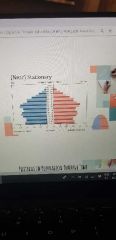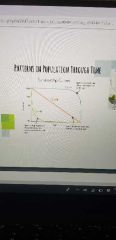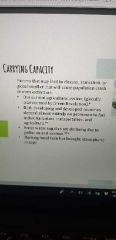![]()
![]()
![]()
Use LEFT and RIGHT arrow keys to navigate between flashcards;
Use UP and DOWN arrow keys to flip the card;
H to show hint;
A reads text to speech;
50 Cards in this Set
- Front
- Back
|
Ancient Greeks |
Delayed age of marriage of men to 30 |
|
|
Xenophon |
Recommended that men should not marry earlier than the age of 30, when sexual desires was less strong, in order to avoid too many children |
|
|
Thomas Robert Malthus |
Created Malthusian Theory of Population |
|
|
Malthusian Theory of Population |
- Essay on principle of human population - Human populations grow exponentially while food production grows @ an arithmetic rate |
|
|
Moral Restraint, Celibacy |
Controls to population suggested by Thomas Malthus |
|
|
Natural Selection |
Foundation in Charles Darwin's Theory of Evolution by ____ |
|
|
Garett Hardin |
Tragedy of the Commons |
|
|
Tragedy of Commons |
- living on a lifeboat (article) - freedom to breed is intolerable - indiv users acting independently accdng to self interest behave contrary to common good of all users - increase privatization of property and resources to limit access to free riders |
|
|
China's One Child Policy |
- 1979 - Parents who adhere were rewarded with benefits and subsidies - Gov't employees have 20% cut in basic salary for 2nd child |
|
|
Intrauterine Device |
IUD |
|
|
Julian Simon |
Ultimate resource is population |
|
|
Cornucopian |
- Promote view that the more the better - rejects idea that earth has finite sources and carrying capacity - combines Adam Smith's invisible hand market
|
|
|
Adam Smith's Invisible Hand |
Self-regulation with belief that technology can overcome all human problems |
|
|
Population |
Totality of organisms of the same species observed in a specific geographical region at a particular time |
|
|
Gene flow |
Refers to the movement of genetic material within a defined group |
|
|
Size |
Number of individuals in a population |
|
|
Population Density |
Number of individuals per unit area |
|
|
Minimal Viable Population |
Smallest number of individuals which can exist without extinction due to random catastrophic variations in the environment, reproduction, and genetic diversity |
|
|
- Uniform dispersion - Random dispersion - Clumped dispersion |
Patterns of population distribution |
|
|
Uniform Dispersion |
More or less equally spaced apart |
|
|
Random Dispersion |
No predictable pattern |
|
|
Clumped dispersion |
Clustered in groups |
|
|
Age-sex Structure |
The composition of a population as determined by the number of proportion of males and females in each age category |
|
|
Birth rate |
Number of births per individual within the population per unit time |
|
|
Death rate |
Number of deaths per individual within the population per unit time |
|
|
Life expectancy |
Average survival time for an individual |
|
|
Exponential Growth (J-curve) |
Increasing very slow at first, but later growing at accelerating rates which show no sign of nearing carrying capacity |
|
|
Logistic Growth (S-curve) |
Population expansion decreases as it reaches carrying capacity |
|
|
Lag Phase |
- Low population density - Adjusting to new environment - Not reached sexual maturity |
|
|
Exponential Phase |
- Have adjusted - Reproduction commences - Increase in individuals |
|
|
Stationary / Plateau Phase |
- Competition for resources - Birth rate = death rate - Fluctuating due to resource availability |
|
|
Carrying Capacity |
Maximum number of individuals that can be supported by a particular ecosystem |
|
|
Demographic transition model |
1) Pre-transition 2) Early transition 3) Late transition 4) Post-transition |
|
|
Expansive (Concave) |

|
|
|
Stationary |

|
|
|
Constrictive |

|
|
|
Patterns through time |

|
|
|
Growth rate of population |
- change in population size per member of the population per unit of time - rate=birth rate - death rate |
|
|
Doubling Time |
- length of time it will take for a population to double in size 70/r |
|
|
Limiting Factor |
- Factors that prevent the further increase of the population - abiotic and biotic |
|
|
R-strategist |
- small size - many offspring produced - early maturity - short life expectancy - each individual reproduces more - type 3 survivorship pattern |
|
|
K-strategist |
- large size - few offspring - late maturity, after prolonged period of parental care - long life expectancy - type 1 or 2 pattern |
|
|
Carrying Capacity |

|
|
|
Urbanization |
- movement of people from the countryside to towns and cities - sinks for resources |
|
|
Location of cities |
Climate, topography, and waterways help determine urban growth |
|
|
Urban sprawl |
Expansion of human populations away from urban centers into a low-density, and usually car-dependent communities |
|
|
- Sustainability - Ecological footprint analysis - Smart cities |
Solutions: populations and sustainable growth |
|
|
Ecological Footprint |
- preliminary tool to asses sustainability - amount of land area you will need to sustain your current lifestyle |
|
|
Smart city |
- efficient in public transportation - intelligent use of land - quality of life - innovate governance |
|
|
- make a bigger pie - put fewer forks on table - teach better manners |
Contribute to ultimate solutions |

